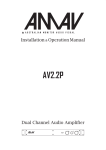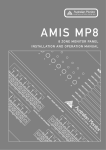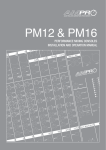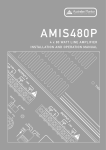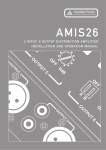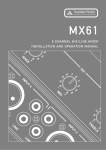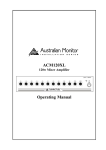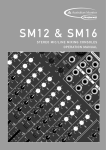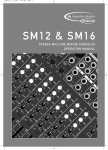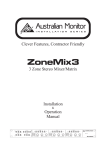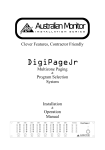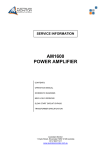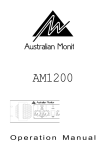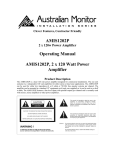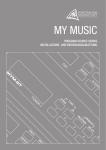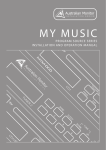Download ZRM4 Manual
Transcript
AMIS ZRM4 6 X 4 ROUTING MIXER INSTALLATION AND OPERATION MANUAL INTRODUCTION AND CONTENTS The AMIS ZRM4 is an easy to use, yet highly featured 1 RU zone routing mixer. It features 6 inputs that can be balanced XLR mic or dual RCA/balanced XLR line level, all of which are available to any combination of 4 zone outputs. Input #1 can be designated as a paging input with priority over all other inputs, individually selectable at each zone output. Front panel switches with LED indication provide for the simple routing of each input. Each input has bi colour status LED indication & 2 stage equalization. Each input has an internal gain trim which can provide a further +/- 15dB of gain, to allow the perfect set up of input gain no matter what the input signal may be. Phantom power & high pass filters are also supplied per input. Each balanced XLR zone output features a dual colour status LED & switchable paging mic priority. Remote VCA's are available for each output allowing for a wall mounted volume control to be installed in remote zones allowing for a volume range from off to whatever the master level on the AMIS ZRM4 relevant zone output is set to. INTRODUCTION 3 FRONT PANEL 4 REAR PANEL 5 INTERNAL ADJUSTMENTS 6 BASIC SETUP AND OPERATION 7 ADVANCED FEATURES 8 BLOCK DIAGRAM 9 SPECIFICATIONS 10 Alert, Evacuation, Bell & Pre Announce tones are provided on board. The AMIS ZRM4 is a compact yet extremely versatile zone routing mixer which makes the complex task of multizone signal routing simple & cost effective. AUS, EUR, USA Copyright 4th Mar 2005 Rev A: 4th Mar 2005 This symbol is intended to alert the user to the presence of uninsulated “dangerous voltage” within the product’s enclosure that may be of sufficient magnitude to constitute a risk of electric shock to persons. This symbol is intended to alert the user to the presence of important operation and maintenance (servicing) instructions in the literature accompanying the appliance. Caution: AMIS ZRM4 INSTALLATION & OPERATION MANUAL To prevent electric shock do not use this (polarised) plug with an extension cord, receptacle or other outlet unless the blades can be fully inserted to prevent blade exposure. To prevent electric shock, match wide blade of plug to wide slot, fully insert. PAGE 3 FRONT PANEL 1 3 4 2 6 SWITCHES These four switches allow you to assign this channel's input signal to any of the four outputs. When the input is assigned, the yellow LED next to the switch will light up. Any combination of buttons may be pushed in (selected) at any time, to select multiple (and therefore mixed), input signals to any output. 2 TONE CONTROLS Each input has a two stage shelf EQ. 3 LEVEL Controls the level of the input signal. PAGE 4 7 OUTPUT CONTROL SECTION INPUT CONTROL SECTION 1 OUTPUT ASSIGNMENT 5 4 INPUT STATUS LEDS Each input has a status LED indicator. The LED is green when there is signal present and red if the signal is approaching clip. The LED begins to light red when the internal signal level is 6dB before clip and is solid red when it is 3dB before clip. Note that the front panel level control is post status LED and as such, the status LED is NOT affected by the level control. See internal adjustment section on page 6. 5 OUTPUT LEVEL CONTROLS These four pots control the level of each output. 6 PRIORITY OVERRIDE ENABLE SWITCHES When active, these switches allow input channel #1 to have priority over all other inputs for the selected output. 7 OUTPUT STATUS LEDS Each output has a status LED indicator. The LED is green when signal is present on the output and is red when the signal peak is above 0dBu (0.775v). AMIS ZRM4 INSTALLATION & OPERATION MANUAL REAR PANEL 6 5 2 3 1 CHANNEL INPUTS Each channel has a dual RCA and XLR input. The RCAs accept line level signals and are internally summed to mono. The XLR accepts balanced mic or line level signals depending on the internal gain switch adjustment. The XLR will also have +15v phantom power if selected on the internal switch. See page 6 for more information about the internal adjustments available. ☛ NOTE: Channel #1 is the priority input and as such is able to cause other signals to be ducked when active. If you have a paging mic, it should be connected to channel #1. Channel #1 is not affected by muting from the chime module or level control from the VCAs, so signals that need to be muted in the event of an emergency or need to be controlled by a remote level control should NOT be connected to channel #1. 4 1 3 CHIME MODULE CONTROL CONNECTIONS These connections are used to trigger the internal tones. Only one tone can be triggered at a time. Triggering occurs by connecting the ALERT, EVAC, BELL or PRE terminal to COM. The pre-announce and bell tones are routed along with input channel #1, whilst the evac and alert tone are always routed to all outputs. 4 VCA Each output level may be controlled by a RC1 remote wall panel or 500k ohm log (A) pot. This connector provides connection for these panels. The VCA is in series and before the master output level controls, so that setting either VCA of Master level control to zero will mute the output. 5 POWER 20V AC This 2.1mm connector accepts 20v AC from the provided power supply. Alternatively, the unit may be powered from a 24-34v regulated DC power supply or battery. 6 EARTH The earth stud provides a location to connect a mains earth strap. A NOTE ABOUT GROUNDING: It may be necessary in some circumstances to ground the AMIS ZRM4 to eliminate noise in the system. This can be done using the earth stud or by making sure that the chassis is electrically connected to the equipment rack (which should be grounded). 2 OUTPUTS The output XLRs provide balanced line level signals. AMIS ZRM4 INSTALLATION & OPERATION MANUAL PAGE 5 INTERNAL ADJUSTMENTS 1 2 3 4 1 HPF When this switch is in the "HPF OUT" position, the signal bypasses the high pass filter. Otherwise the signal is filtered by a high pass filter with a knee of approximately 150Hz. This is useful in removing "thumps", "pops" and "rumble" when using the input with a lectern or handheld microphone. 5 4 GAIN TRIM The input gain can be cut or boosted by up to 15dB using this control. This control affects both the XLR and the RCA inputs. This allows a wide rage of program sources to be set up with optimum gain structure. With the gain trim in the centre position, the boost/cut is set to 0dB. See the block diagram on page 9 for details of the gain structure. 2 PHANTOM 15v phantom power is available for condenser or electret microphones on the XLR input when this switch is in the "PHANTOM ON" position. 5 TONES LEVEL This controls the level of all the tones generated by the tone module. 3 MIC / LINE These two switches control the sensitivity of the XLR input. In the "MIC" position the XLR input is suitable for use with microphones; in the "LINE" position the XLR input is suitable for use with a balanced line level signal. ☛ NOTE: Both MIC/LINE switches must be in the same position for correct operation of the balanced input. The MIC/LINE switches only affect the XLR input. PAGE 6 AMIS ZRM4 INSTALLATION & OPERATION MANUAL BASIC SETUP AND OPERATION The inputs of the AMIS ZRM4 can accommodate a wide range of sources including dynamic microphones, DVD and CD players. The zone outputs may be used to drive power (booster) amplifiers, mixers or mixer amplifiers. Each installation will require setting the appropriate relative mix of levels between microphones, program sources and tones for each zone and balancing between the zones. Because of the variation in levels between the possible sources, AMIS ZRM4 offers a number of gain stage adjustments so you can set the correct levels for your application. TEST THE INPUT LEVELS For each source, try to achieve the highest signal level possible. i.e. for a CD player, cassette deck or other music source, put on the loudest anticipated program music or for a paging mic make a loud page. During this signal condition, the input status LED should light green and may occasionally turn red for a short period. If the status LED stays red (more than 5% of the time), you should reduce the input gain trim. If the status LED never turns red at all, you may wish to increase the input gain trim if required. Also consider what the outputs are driving…. ASSIGN THE SOURCES TO THE OUTPUTS Setting up correct gain structure through the whole system is important to achieve optimal results. For each input, activate the appropriate output assignment switches to the outputs you wish the signal to be routed. Yellow LED's will indicate which input is routed to which output The following step by step procedure has been devised to assist during the setup process. When the AMIS ZRM4 was shipped to you from the factory, it was set up in a particular way. In the following procedure it is essential that you are starting from these initial settings. SET UP THE PRIORITY FUNCTION + Program Input Gain Controls + XLR Mic/Line switch + Input Level Controls + Output Level Controls SET THE LEVELS – half (12 o’clock) – MIC – off – off CONNECT THE SOURCES First connect all the required sources to the appropriate input connectors. If the source is a microphone, set the MIC/LINE switches to the "MIC" position. If the source is an electret or condenser microphone, set the phantom switch to the "PHANTOM ON" position. If the source is a microphone used for speech such as for paging, set the high pass filter switch to the "HPF ON" position. If one of the sources needs to have priority over the some other sources (paging or jukebox), ensure that it is connected to input channel #1 as this is the designated priority input. ☛ If a priority signal such as a paging mic or line source is required, switch the priority override enable switch to the on position (in) for that zone. (See page 8 for further information) Turn the input levels up to 5. For each output, turn up the level until it is at an appropriate level for the listening environment. You will now have to adjust the relative levels of the inputs to achieve a good balance for each zone. It is generally a good idea to set up the priority signal (if any) first. The aim of these adjustments is to have all level controls at between 3 and 7. This may not be possible however. A good rule of thumb is that input level controls should be higher than the output level controls. NOTE: The high pass filter has a knee around 160Hz and a roll-off of 6dB/octave. Using the HPF helps to eliminate thumps and rumble often heard through paging mics. CONNECT THE OUTPUTS Turn the amplifiers off. Connect the AMIS ZRM4’s outputs to the amplifiers' line level input. Check that the AMIS ZMR4 is on, then turn on the amplifiers. If the amplifiers have a level controls, set them to maximum. AMIS ZRM4 INSTALLATION & OPERATION MANUAL PAGE 7 ADVANCED FEATURES TONE CONTROLS TONE MODULE Each input channel includes bass and treble trim pots which may be used to adjust the tone of the signal. The bass trim offers +/- 12dB of cut/boost to signals at 100Hz. The treble trim offers +/- 10dB of cut/boost to signals at 10kHz. The tone module generates four separately triggerable and priorioritised tones. They are listed in order of highest to lowest priority. Each tone is triggered by shorting the "COM" pin of the tone module control lines connector to its associated pin. Using the bass cut in association with the high pass filter is useful for further reduction of rumble from microphones. EVAC - An evacuation signal. Triggered by shorting the EVAC pin to the COM pin. The EVAC signal will continue until the short is removed. Triggering the EVAC signal will mute all inputs except channel #1. ☛ ☛ NOTE: Attempting to add bass to systems that can not reproduce bass well (such as transformer coupled ceiling speakers or horn speakers) will only reduce the headroom of the system and contribute to distortion. NOTE: adding bass or treble boost may cause the input to clip, so keep an eye on the input’s status LED, and reduce the gain trim if required. ALERT - An ALERT/alarm signal. Triggered by shorting the "ALERT" pin to the "COM" pin. The ALERT signal will continue until the short is removed. Triggering the alarm signal will mute all inputs except channel #1. BELL - A chime like a BELL being struck twice, a short gap and then repeated. Triggered by shorting the "BELL" pin to the "COM" pin. The BELL signal will continue until the short is removed. PRIORITY OVERRIDE Each output channel has the ability to mute all other input signals in the selected output when there is signal present on channel #1, if channel #1 is assigned to that output. To enable this function activate (press in) the "CH1 Priority Enable" switch for the required output and assign channel #1 to that output. This is useful for paging microphones, juke boxes and other situations where an occasional signal needs to interrupt the normal programme. PRE-ANNOUNCE - A four note chime, suitable for use before a page is made. Triggered by shorting the "PRE" pin to the "COM" pin. The PRE-ANNOUNCE chime will sound only once for each time the chime is triggered. ☛ NOTE: The bell and pre-announce chimes are routed with signals from channel #1, thus any output which has channel #1 assigned to it will also receive these tones. The EVAC and ALERT signals are routed to all outputs AFTER the level controls. This is to ensure that all zones receive these tones. ☛ NOTE: Because EVAC and ALERT do not mute channel #1, it is not advisable to connect a continuous source (such as a radio or CD player) to this input. REMOTE VOLUME CONTROL The level of each output may be controlled via a RC1 remote level control panel or 500k ohm log (A) pot. For each output there are two pins on the connector labeled VCA on the rear panel. The RC1or 500k ohm log (A) pot should be connected to these pins. Please note that the remote level control inserts before and in-line with the output level control so the RC1 sets the maximum output level (for normal signals) and the front panel master attenuates from that level. Also note that an RC1 control will have no effect on the signals from input channel #1 or any of the tones generated by the tone module This is so that the paging can not be turned off in a zone it has been assigned to. If paging is too loud in a zone, the master output level control for that zone should be turned down. ☛ NOTE: If using a 500k ohm pot, the connections should be made to the wiper terminal and the anti-clockwise terminal. i.e. max resistance = max volume PAGE 8 AMIS ZRM4 INSTALLATION & OPERATION MANUAL BLOCK DIAGRAM AMIS ZRM4 INSTALLATION & OPERATION MANUAL PAGE 9 SPECIFICATIONS PAGE 10 AMIS ZRM4 INSTALLATION & OPERATION MANUAL SPECIFICATIONS DIMENSIONS (h x w x d) WEIGHT POWER INPUT 44 x 482 x 188mm Net 2.9kg Shipping 4.4kg Net 6.4lb Shipping 9.7lb 20VAC 600mA max or 24 to 34v DC regulated 600mA max FREQUENCY RESPONSE <5Hz to >22kHz (0dB/-3dB) THD less than 0.1% NOISE CROSSTALK: PHANTOM POWER SENSITIVITY RCA IN XLR LINE IN XLR MIC IN (input required for 0dBu out) -26dBu to +4dBu (39mV to 1.23 V) -26dBu to +4dBu (39mV to 1.23V) -60dBu to -30dBu (0.78mV to 25mV) MAX LEVEL IN >14.1Vrms (+25dBu) MAX LEVEL OUT >15.4Vrms (+26dBu) AMIS ZRM4 INSTALLATION & OPERATION MANUAL <-90dBu 20Hz-20kHz (all pots centred) <-65dB @1kHz 15VDC PAGE 11 AUSTRALIA AND NEW ZEALAND www.australianmonitor.com.au SYDNEY MELBOURNE BRISBANE ADELAIDE PERTH AUCKLAND (NSW & ACT SALES) (VIC & TAS SALES) (QLD SALES) (SA & NT SALES) (WA SALES) (NZ SALES) 149 Beaconsfield Street Silverwater NSW 2128 Private Bag 149 Silverwater NSW 1811 Phone: (02) 9647 1411 Fax: (02) 9648 3698 Email: [email protected] 22/277 Middleborough Road Box Hill VIC 3128 PO Box 151 Blackburn South VIC 3130 Phone: (03) 9890 7477 Fax: (03) 9890 7977 Email: [email protected] 42 Commercial Road Fortitude Valley QLD 4006 PO Box 871 Fortitude Valley QLD 4006 Phone: (07) 3852 1312 Fax: (07) 3252 1237 Email: [email protected] 31 Walsh Street Thebarton SA 5031 PO Box 157 Hindmarsh SA 5007 Phone: (08) 8352 4444 Fax: (08) 8352 4488 Email: [email protected] 299 Fitzgerald Street West Perth WA 6005 PO Box 404 North Perth WA 6906 Phone: (08) 9228 4222 Fax: (08) 9228 4233 Email: [email protected] Unit B, 11 Piermark Drive Albany 1331 New Zealand PO Box 512 Albany 1331 Phone: (09) 415 9426 Fax: (09) 415 9864 Email: [email protected] EUROPE/ASIA/MIDDLE EAST USA/SOUTH AMERICA www.australianmonitor.com.au www.australianmonitor.com INTERNATIONAL SALES SENNHEISER ELECTRONIC CORPORATION 149 Beaconsfield Street Silverwater NSW 2128 Australia Private Bag 149 Silverwater NSW 1811 Phone: 61 2 9647 1411 Fax: 61 2 9648 3698 Email: [email protected] 1 Enterprise Drive Old Lyme CT 06371 USA Phone: 1 860 434 9190 Fax: 1 860 434 1759 Email: [email protected]












